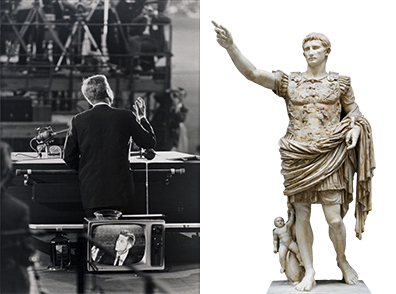Test your knowledge with a quiz
Winogrand, Democratic National Convention
Key points
-
- Television played a key role in the 1960 presidential campaign. After his nomination at the Democratic National Convention, John F. Kennedy appeared next to his Republican opponent Richard Nixon in the first presidential debate ever broadcast to a national audience. Many historians believe that the appearance and demeanor of the candidates as seen on TV had a direct impact on the election.
- Kennedy’s nomination represented a new direction for the Democratic party. While the establishment worried that his youth and his Irish-Catholic background would be liabilities in the general election, the 1960 Democratic Convention marked a shift toward a new generation of leaders and a more open nomination process.
- As a street photographer, Garry Winogrand used split-second timing to capture images that are both spontaneous and simultaneously dense with meaning. Here, Kennedy’s gesture recalls famous leaders of the past, while his appearance on the TV screen alludes to his status as a modern celebrity. Other details of the photograph took on symbolic significance following Kennedy’s assassination in 1963, reminding us that works of art are open to continued interpretation and renewed meaning.
Go deeper
See this photograph in the collection of the Minneapolis Institute of Art
Use primary source documents to learn about the 1960 presidential election
Learn more about John F. Kennedy’s presidency
Learn about the impact of television on the news media in the 1960s
Read more about Garry Winogrand
More to think about
Kennedy’s presidency coincided with the rise of television and its role in mediating our interactions with and connection to politicians. How do you think the emergence of social media has affected that relationship and the public’s direct access to our political leaders?

 In their comparison of Kennedy’s image to the Augustus of Primaporta, the speakers suggest that Winogrand’s photograph
In their comparison of Kennedy’s image to the Augustus of Primaporta, the speakers suggest that Winogrand’s photograph
